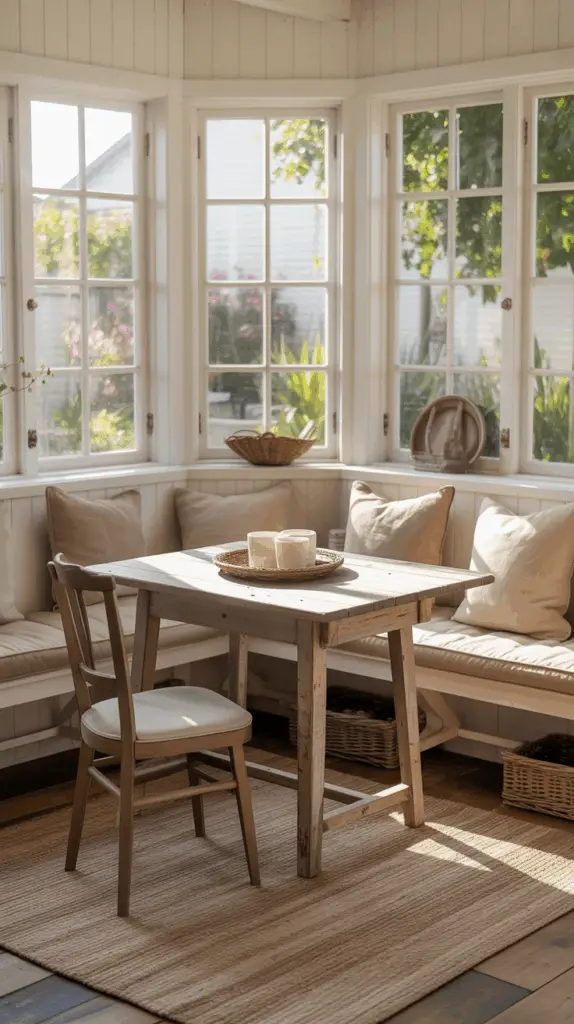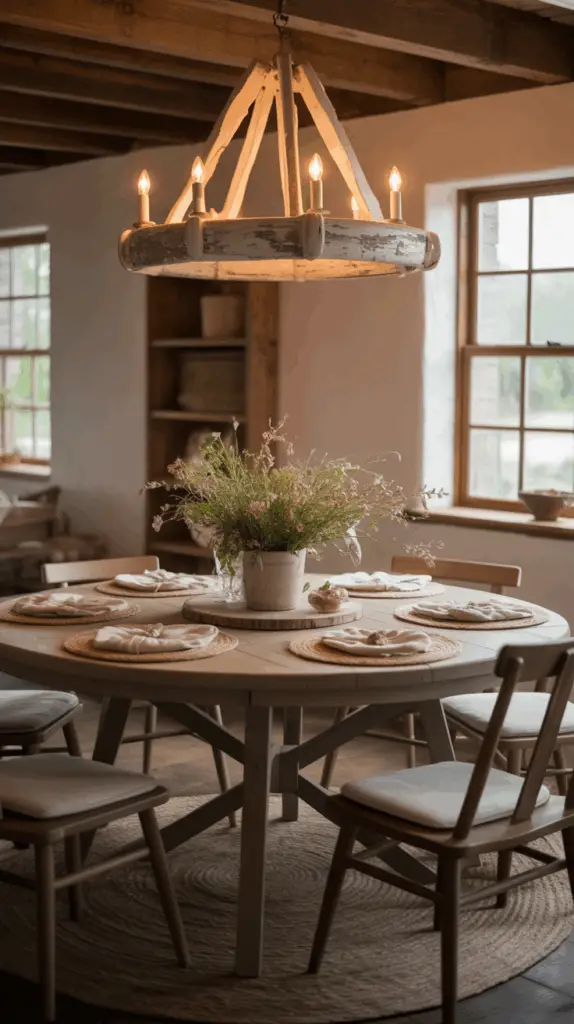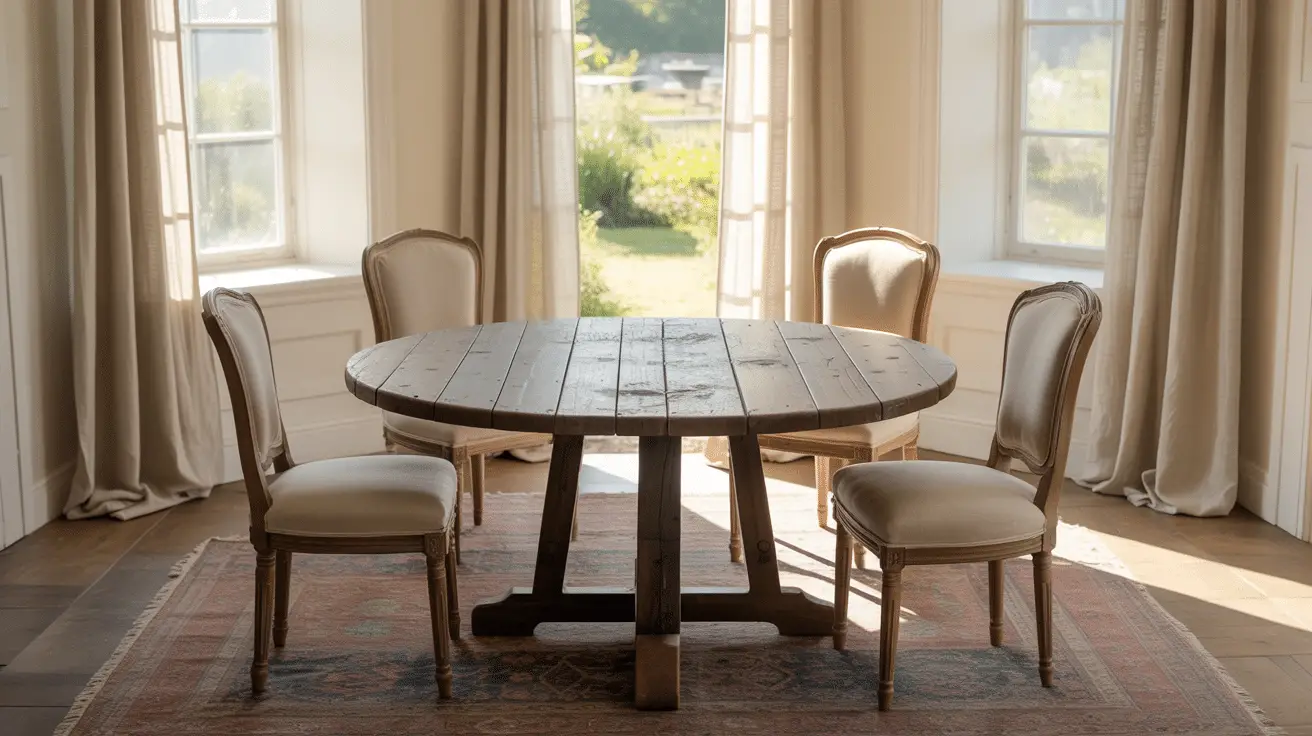Small Space Farmhouse Dining Room Table Layout Tips for Style and Function
Table of Contents
Introduction
Designing a dining area in a small space can feel like a challenge—but it doesn’t have to be. When done thoughtfully, even the tiniest nook can become a charming and functional farmhouse-style dining room. With the rise in popularity of open-concept living and downsized homes, small space solutions have become a top priority for homeowners looking to maximize both comfort and style.
The farmhouse aesthetic, known for its welcoming warmth and timeless simplicity, fits beautifully into compact spaces. It embraces natural textures, vintage character, and functional furniture—all qualities that align perfectly with the needs of a smaller dining area. In fact, when scaled right, farmhouse design can actually make a small dining room feel more open and intentional rather than cluttered or cramped.
This article will guide you through a series of small space farmhouse dining room table layout tips, from choosing the right furniture and optimizing seating to using lighting, color, and storage creatively. Whether you’re furnishing a cozy breakfast nook, an eat-in kitchen, or a tiny open-plan dining zone, these tips will help you design a space that feels both personal and practical—without sacrificing the rustic charm you love.
Choose the Right Table Size and Shape for the Room
The foundation of any dining layout is, of course, the table itself. In a small farmhouse-style dining room, the table must be both functional and space-savvy. Start by measuring your room carefully, factoring in not just the dimensions of the table, but the clearance required for chairs and movement around the perimeter.
Round tables are particularly useful in tight quarters. They allow for more flexible seating and eliminate hard corners, which helps maintain good flow in small rooms. A pedestal-style round table offers more legroom and works beautifully with mismatched chairs for that classic farmhouse look.
If your space is narrow, a rectangular or oval table can tuck neatly against a wall or be extended only when needed. Drop-leaf or extendable tables are excellent options, offering flexibility for both everyday meals and entertaining.
Wood is the go-to material for farmhouse tables—look for finishes like whitewashed oak, weathered pine, or reclaimed barn wood. These add texture and character while staying timeless.
Table: Choosing the Ideal Dining Table for Small Farmhouse Spaces
| Table Shape | Best Use Case | Farmhouse Appeal |
| Round | Square rooms, open floor plans | Softens the space, cozy ambiance |
| Rectangular | Narrow rooms, wall-adjacent layouts | Classic farmhouse silhouette |
| Drop-leaf | Multifunctional rooms, flexibility | Functional and charming |
| Square | Compact spaces, breakfast nooks | Symmetrical and versatile |
Maximize Seating with Benches and Multipurpose Pieces
In a small farmhouse dining area, traditional chairs can sometimes feel bulky or restrict movement. This is where benches and dual-purpose furniture shine. Not only do they free up visual space, but they also offer more seating without increasing clutter.
A classic wooden bench along one side of the table creates a relaxed, communal feel—perfect for casual meals and family gatherings. When not in use, benches can be pushed under the table to keep the room feeling open and clean. Some benches even include hidden storage, making them practical for stowing linens or seasonal decor.
Banquettes are another great option. Built-in or standalone, these L-shaped seating solutions optimize corner spaces and can double as additional storage. Pair a banquette with a round or oval table for easy access and a snug, café-style nook.
For even more flexibility, consider stools, ottomans, or stackable chairs that can be brought out when needed and stored away otherwise. These choices reflect the informal charm of farmhouse design while meeting the demands of a smaller space.
Table: Space-Saving Seating Solutions
| Seating Type | Ideal Feature | Space-Saving Benefit |
| Bench | Pushes under table, rustic look | More seating, less bulk |
| Banquette | Corner use, built-in storage | Maximizes unused areas |
| Stools/Ottomans | Lightweight, stackable or cushioned | Easy to move and hide when needed |
| Slim Chairs | Armless, spindle back, minimal profile | Keeps room feeling airy |

Layer Textures and Lighting for Warmth Without Clutter
In small dining areas, texture and lighting can transform the room’s mood without adding unnecessary objects or furniture. The farmhouse look thrives on natural, tactile materials—think distressed wood, linen, rattan, iron, and wool. By layering these textures thoughtfully, you create depth and coziness that makes even the smallest room feel full of character.
Start with a soft area rug to anchor the table. Choose a flatweave or jute option that’s easy to clean but adds visual interest underfoot. Pair this with linen or cotton seat cushions, and use a woven placemat or burlap runner to tie the table into the room’s palette.
When it comes to lighting, a single overhead pendant can set the tone for the entire dining space. A lantern-style fixture or a wood-and-metal chandelier offers rustic charm, while warm Edison bulbs or dimmable options keep the ambiance cozy and welcoming.
Supplement the main light with wall sconces or small table lamps on a nearby sideboard if space allows. Layered lighting makes the room feel larger, and the warm glow complements natural textures beautifully.
Table: Texture and Lighting Ideas for Small Farmhouse Dining Rooms
| Element | Material Suggestions | Effect on Space |
| Area Rug | Jute, flatweave, vintage-style | Softens space, defines layout |
| Table Textiles | Linen runners, woven placemats | Adds charm and subtle color |
| Pendant Lighting | Iron, aged brass, wood-beaded fixtures | Focal point, cozy atmosphere |
| Accent Lighting | Sconces or sideboard lamps | Enhances depth and warmth |

Use Wall Space Creatively for Storage and Style
When floor space is limited, vertical space becomes a design opportunity. Utilizing your walls for both storage and style is essential in a small farmhouse dining room, where clutter can easily overwhelm.
Floating shelves offer a balance between form and function. They provide a place to store or display everyday items—plates, mugs, woven baskets, or small vases—and keep essentials within reach without sacrificing surface space.
Wall-mounted racks or hooks can be used to hang cutting boards, vintage kitchen tools, or even fresh herbs. These practical displays also double as decor, adding rustic authenticity and charm.
Mirrors are another smart addition. A well-placed mirror can reflect natural light and visually double the space, making the room feel more open. Choose mirrors with wooden or distressed frames to stay true to the farmhouse style.
If your space allows, a narrow console or wall-mounted sideboard adds surface area for serving or decor. Choose pieces with open shelving or glass fronts to maintain an airy feel.
Table: Functional Wall Decor Ideas
| Wall Element | Function | Farmhouse Style Benefit |
| Floating Shelves | Storage + Display | Layered decor, rustic materials |
| Wall Hooks/Racks | Hanging kitchen tools or textiles | Adds charm and utility |
| Mirror | Reflects light, expands space | Opens up the room visually |
| Narrow Sideboard | Serving space + closed storage | Complements table without bulk |
Define the Dining Area with Layout Tricks and Visual Anchors
In open-plan spaces or compact multi-use rooms, defining your dining zone is essential. Without walls or clear boundaries, the dining table can get lost or feel out of place. Fortunately, a few smart layout strategies can create a visual anchor without the need for physical partitions.
Use a rug that matches the width and length of the table plus chairs. This instantly marks the dining area while adding warmth and softness. Choose natural materials and tones that complement your farmhouse palette.
Lighting, again, becomes a cue—positioning a pendant light or chandelier directly above the table naturally defines the space. This works especially well in lofts or open kitchen-dining layouts.
Wall color and decor can also create subtle division. For example, painting the dining zone wall in a slightly deeper tone or adding wainscoting or beadboard behind the table adds structure and charm. Hanging art or shelves above the table provides visual weight and makes the space feel purposeful.
Even the orientation of your table—centered under a light fixture or aligned with a window—helps to carve out a dining “zone” that feels intentional.
Table: Simple Ways to Define a Small Dining Area
| Strategy | Execution Example | Visual Impact |
| Anchor with Rug | Natural jute or neutral vintage pattern | Grounds the table and seating |
| Use a Feature Wall | Beadboard, contrast paint, framed art | Adds personality and structure |
| Centered Lighting | Pendant or chandelier over table | Draws attention to dining space |
| Furniture Placement | Align table with architectural features | Enhances flow and functionality |
Conclusion
A small space doesn’t mean you have to compromise on character or function—especially when embracing the inviting charm of farmhouse design. With the right table shape, smart seating choices, layered textures, and clever use of lighting and vertical space, you can create a dining area that feels both stylish and deeply personal.
Each design choice should serve your lifestyle while enhancing the cozy, lived-in aesthetic that makes farmhouse interiors so beloved. Whether you’re styling a compact nook or an open-concept corner, these layout tips can help you turn your small dining area into a warm and welcoming centerpiece of your home.

